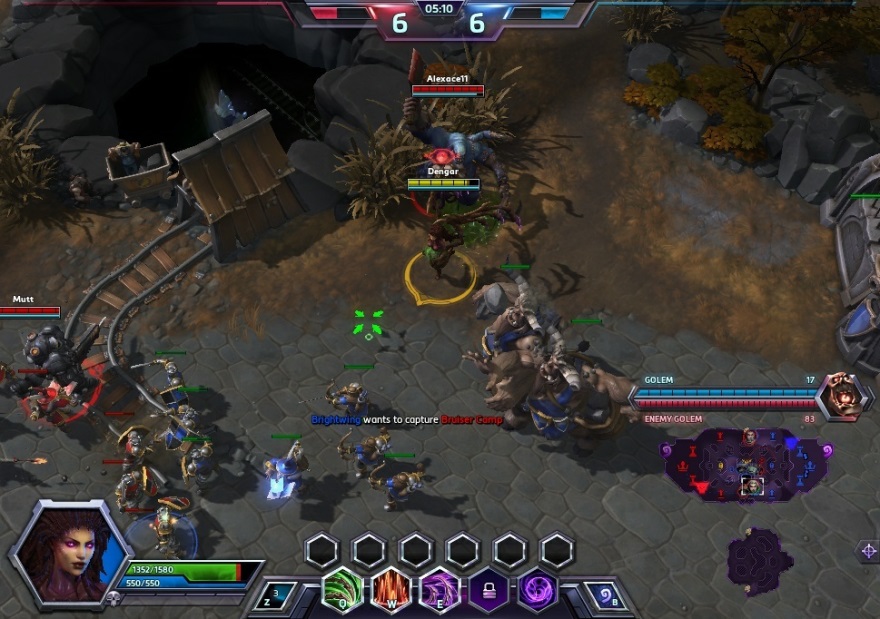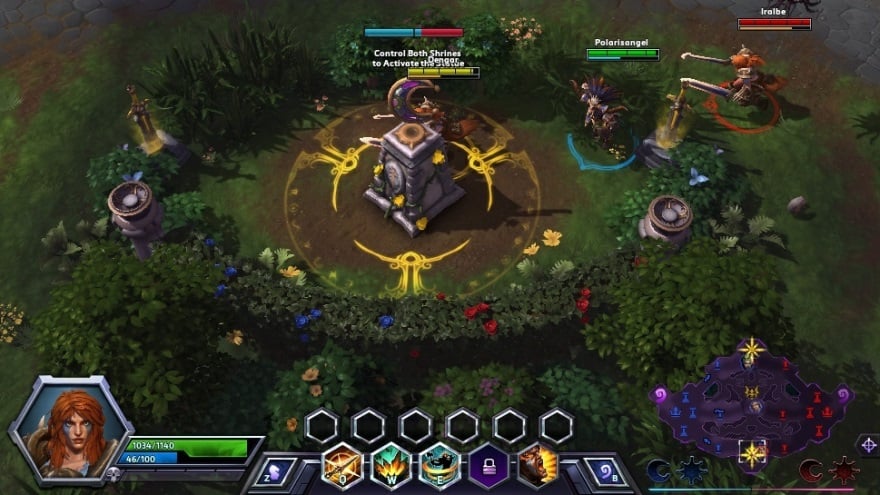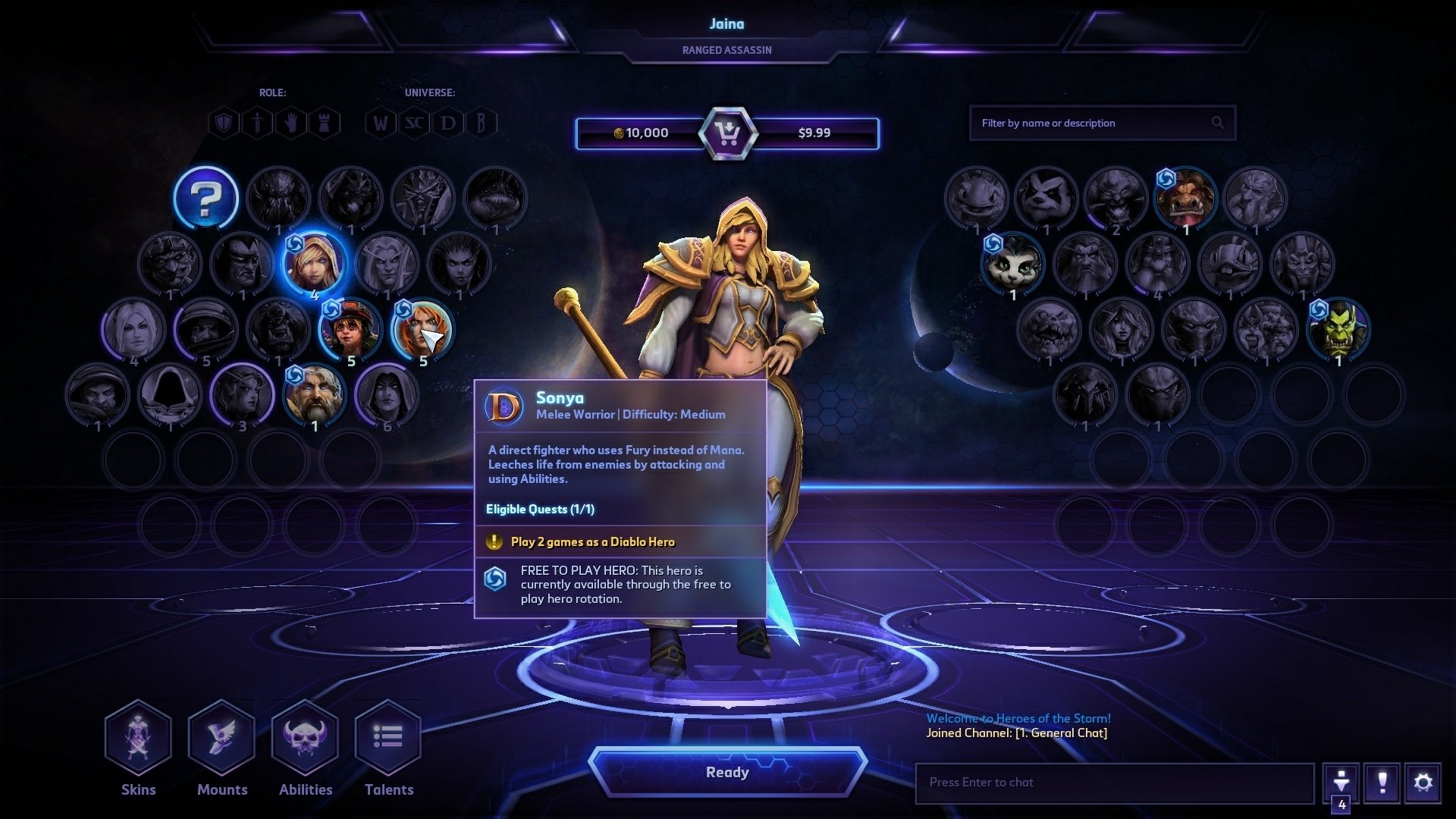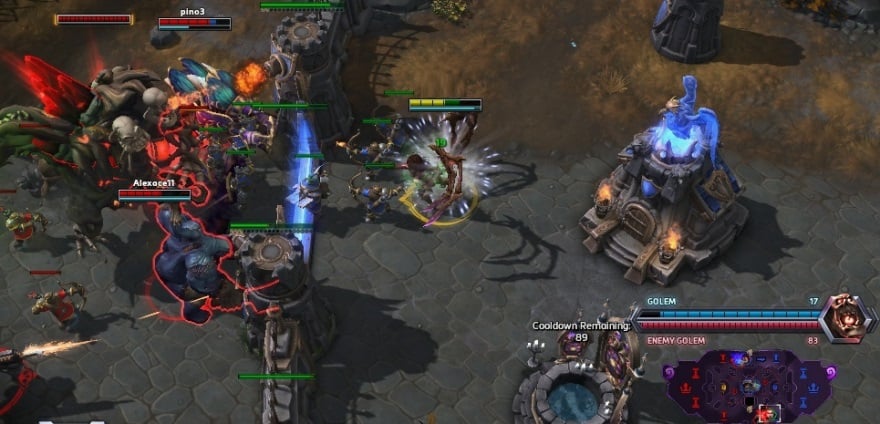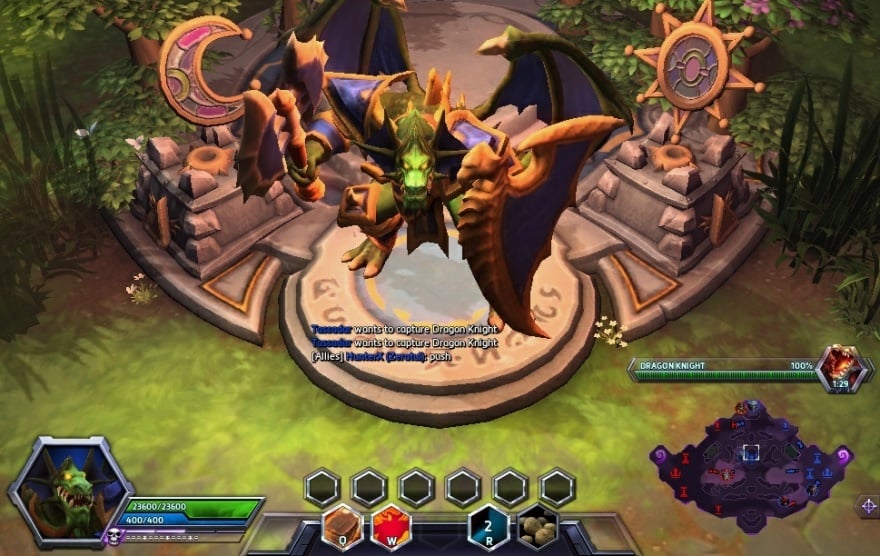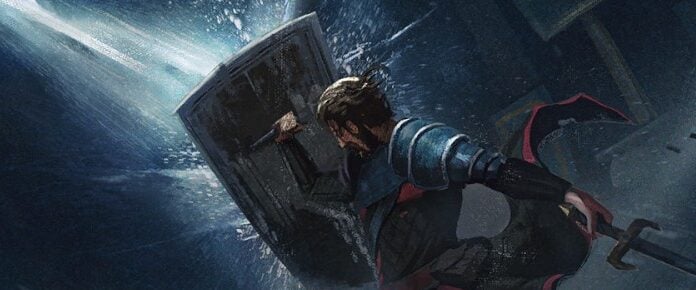
So you’ve heard about MOBAs by now, right? Maybe you tried League of Legends, or the idea behind DOTA 2 was too confusing to inspire a download. Now there’s this Heroes of the Storm thing coming out and you find yourself oddly excited (or being badgered by friends to get in game). Plus, it’s Blizzard, and you can’t pass up a Blizzard game. What’s an MMO fan to do?
Worry not, dear reader! As someone who has played quite a few MOBAs, I’m here to give you a quick rundown of the genre, how Heroes of the Storm works, and some tips on surviving and thriving in the game.
What is a MOBA?
Let’s start with the bare basics: A MOBA is type of real-time strategy (RTS) game that puts you in control of a single unit that gains levels within each match. This unit can be customized during the battle, which often consists of two teams trying to gain control of each other’s bases (as in many MMO battlegrounds).
There is often a big emphasis on leveling through battling NPCs while also having to battle enemies; NPCs tend to walk in a straight line towards the opposing base down a path or “lane.” Often there are three lanes, and in each lane, there are “towers” that will attack an enemy player attacking an allied player, attack the first enemy (player or NPC) they see, and then attack the next closest (usually) NPC enemy, in that order. Players can leave the lanes and venture into the “jungle,” an area of the map with harder NPCs that provide boosts and bonuses, but it is usually shrouded in a fog of war and will not be penetrated by your NPCs.
Outside of each match, your character usually gains levels for various purposes (unlocking talents, game options, etc), as well as some form of currency to either purchase new units/”heroes” or new appearances/”skins” for characters you already own. Heroes tend to be fairly unique in their playstyles but fall into certain classes.
As you probably have heard, MOBAs tend to attract a rather competitive sort of player who expects teammates to know at least as much about the game as he does, and anyone who does not is openly ridiculed. It can be rather harsh, even for veteran MMO player-killers like yours truly.
How is Heroes of the Storm different?
HotS is to MOBAs what Mario Kart is to racing games. It streamlines certain mechanics and emphasizes a broad appeal over catering to core fans of the genre. Other MOBAs, like Solstice Arena, are far more streamlined and accessible, but HotS is a Blizzard product using IPs you’re probably much more familiar with, as are your friends.
That said, Blizzard has diverged from the usual MOBA mold. First, there are no in-game items. In League of Legends, for example, you buy certain items with money made in that match (which doesn’t carry over to future games) to customize your character, and you upgrade those items more and more as the game goes on. You have many options, some of which are really not very good, and you are making these decisions while the enemy team may be raiding your base.
Instead, HotS uses talents, similar to World of Warcraft‘s. You choose a new talent to modify or even add an ability at certain levels; at level 10, you choose your ultimate ability, a move that usually is quite powerful and on a long cooldown. While you’re new, you have access to only one or two options, but as you level up that hero’s persistent level (as opposed to the match-only level), you’ll gain more. That makes actually playing the game much easier while still allowing some customization.
The game also mostly gets rid of the traditional MOBA jungle as a series of spawn points to memorize and mentally time for optimal farming. Instead, the jungle has “mercenaries,” NPCs who, when defeated, will fight in the lanes for your side.
In addition, Blizzard has added events. Most MOBAs have only one or two straightforward maps, but HotS has several, each with an event that can usually be boiled down to kill/collect quests. These largely appear in the jungle. An NPC will announce when these events take place, or sometimes you can see on the minimap when an event or respawn will take place. This further incentivizes jungle play.
This is why some people say HotS is more about team battles than laning. In most MOBAs, your jungler is trying to maximize her experience gain while also striking from the shadows to help her mates in their lanes (even in HotS, the middle lane is the most dangerous because people can invade from either the top or bottom lane). In HotS, because there are objectives in the jungle, and because they tend to give powerful bonuses, traveling together is almost necessary. Unless you can stealth or are several levels above the other team, a 2v1 fight will usually end in your death.
This is another important aspect of HotS: All the members of your team level up at the same time. If you do something that gives experience, your teammates get it too. If you’ve played a MOBA before, don’t worry about “last hitting,” since it’s not in the game at all.
The game also has mounts to speed up travel time and “fountains” for healing. These help keep downtime low and get you back into action quickly. Don’t use that as an excuse to die, though! As in all MOBAs, the longer the game goes on, the longer you have to sit out when you die. That three-second respawn will turn into 30 seconds faster than you think, and a lot can be done in that short amount of time. Better to run away and heal than wait to respawn.
Finally, as mentioned before, HotS also gives individual levels to heroes that persist from match to match. These unlock additional talent options at first, but then unlock special skins for both heroes and mounts, plus profile icons. It gives you more non-premium diversity than most MOBAs do. In short, this is a MOBA that has cut a lot of fat, added in MMO aspects that made World of Warcraft appealing, and gives away some customization options that other companies usually only sell you.
Heroes of the Storm basics for MMO fans
As an MMO fan, you have a lot of advantages when picking up a MOBA. You already know several mechanics, like capturing bases and basic group compositions (tank, healer, DPS), and that the key to success in a BG is good team communication.
In HotS, “warriors” are tanks, “assassins” are DPS, and “support” are (mostly) healers. Then you have the “specialists.” This is perhaps easier to understand if you’re an old-school MMO player. These are the mezzers, the hybrids, the bards. The role they serve will often be quite different and involve a more unique playstyle. For example, some units specialize in destroying structures, such as towers. Others may be better at fighting NPCs. In short, these will usually be the harder characters to use.
There are also daily quests (unlocked at account level 6). You can do your quest the day you receive it, or try to save a few up and complete three in a single sitting; matches usually last 15-20 minutes, and quests usually involve playing 2-8 matches, often under certain conditions, such as using a special class or character from a specific IP. You could even try to maximize your gold-earnings.
You’re also probably used to PvE boss fights. There will be red stuff to not stand in, adds to avoid/CC/kill, and times when you may need to quickly figure out which hero/heroes are best suited to run in and take down key NPCs while the rest of your team stalls the enemy. Staying in a lane to fight NPCs is easy enough for genre fans, but those averse to PvP may need to keep an eye open for instructions from the more aggressive players. I’d opt to choose ranged assassins for pure PvE types, as it gives you an excuse to stay in the back follow more seasoned players into battles.
If you’re a fan of MMO battlegrounds, you’ll adapt very quickly. You already know that healers must die and that the tank should usually be killed last unless she overextends. The same applies here. Once you have the lingo down, learning the meta will become quite easy.
Learning the game
Don’t think of playing a MOBA quite the same as playing an MMO: You won’t have a single “main” character, especially if you want to play competitively. If you’re looking to be particularly useful (or have shorter queues), playing a support role should be your priority. In April, Blizz noted that teams with more healers won more games than those without, and the studio had to make some changes to its match-making system based on this. I suggest going with Lili first, since she has a lot of healing options with few gimmicks, and her trait increases her run speed if she gets hit. When you’re new to MOBAs, running away is one of the first things you need to learn, and her trait encourages this habit.
For warrior-types, I suggest E.T.C.; I find him very boring, but he comes with a lot of healing (for you or possibly as support), and Powerslide can be used both to charge to or away from enemies. This guide is quite easy to understand and will make playing him easier.
Assassins are one of the trickier classes to play, so new players may want to avoid the melee versions. Tanks can go in, kill, and survive with less thought and management than melee assassins. The ranged ones, however, give you… range. That buys you a little extra time to run away. You can’t take a hit like melee assassins can, but Raynor and Valla are strong picks for beginners because they have good escape tools and healing with few gimmicks to learn. But overall, I’d start with Lili first to make sure you learn that whole “run away and don’t die” lesson early.
Specialists are a mixed bag and difficult to summarize for beginners. You’ll probably get a quest to try them; if possible, pick Sylvanas first. She’s basically a mezzer and pretty easy to play, especially if you’re a PvE person. Note that her trait is PvE-only, so don’t think you can keep another player stunlocked.
Now, for some more general advice. If you’re thin skinned, read chat on how to turn off ally chat, and do it fast. Despite Heroes of the Storm’s more lighthearted feel, players during alpha and beta were at least as bad as the LoL community. There are helpful people, but they’re rare. Brings friends, and listen to pings. When someone pings you (there’s a sound and a message about assisting you), it means he wants you to pay attention to the map/chat. This also lets you wordlessly communicate too. See an enemy who keeps barely escaping? Hold “alt” and click him on the map to note he should be killed. Is your base under attack? Again, hold “alt” and click it.
If you do leave chat on, though, you might be able to meet new people. You can add people to your friends list via the UI panel when you hit the “tab” key. You can also use this screen to block people. If you do decide to leave chat on, I advise you to perhaps stick with the co-op mode for the first 4 levels, not PvP quick matches. This lets you learn the hero and the maps and helps you unlock more moves. Plus, each hero you get to level 5 gives you a 500 gold bonus, which makes it easier for you to buy the heroes you want. Of course, before you buy, know that you can test heroes and skins to make sure you’re happy with your potential purchase!
Massively’s former sister site Blizzard Watch has a nice summary of the various maps you’ll be playing on, but my advice to beginners would be that if you hear the map announcer announce an event and three people are moving toward the same area, move with them and prepare for a team fight, even if you think it’ll just be fighting a boss. If you’re the first there, hide in tall grass away from the objective until your allies arrive. Also, if you take siege units (like becoming your team’s Shambler or Dragon Knight), focus on destroying the enemy’s base. Don’t stop to kill enemies! Your teammates should help support your push, but you can make it easier on them by going down the lane most of them are in.
Movement is big in MOBAs. Don’t expect to PvE in the same lane the whole time. Try moving around a bit. Explore! Fight the mercenaries, especially if you’re playing with a friend (being partied with a friend gives you an experience bonus anyway, and if you’re both learning, it gives you someone you trust to let you know you did something unwise). Your priority should always be on doing the events, as a team. Mercenaries are also important a few levels in. Laning is your last priority.
One last suggestion: Don’t look at the scoreboard too much. At the end of the match, sure, check the talents tab to see what people are often using and learn from that. However, during a match, it doesn’t matter whether someone has more damage dealt and lots of kills. That player might be playing poorly by neglecting objectives that are destroying your base and costing your whole team the match. Focus on the overall war, not the little battles and points. If there’s only one thing you learn from this guide, learn that. Grab a friend, go into the nexus, and have some fun.

